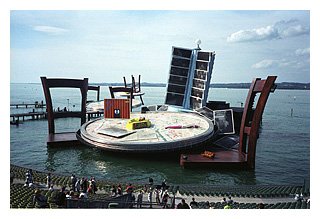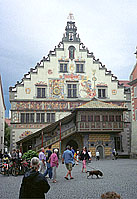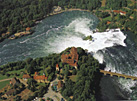
Last bike trip August 2001
Directions to bicycle the Bodensee Circuit — Lake Constance, and Rhinefalls
Organize the cycle tour yourself, or bike and rent from a tour operator
Bike Rating: Very Good
Nature of the Ride: The Bodensee, known in English as Lake Constance, is the third largest lake in Western Europe — after the IJsselmeer in the Netherlands, and Lake Lehmann in Switzerland (known in English as Lake Geneva). Whereas Lake Lehmann is ringed by highways and busy cities without many bike routes, the Bodensee is ideal for easy lake-view biking out of traffic's way. The Bodensee is fed by, and drained by the Rhine River, which gathers it waters in the Swiss and Austrian Alps, and, after the lake, eventually dumps them into the North Sea. The falls of the Rhine river, the largest falls in Europe and a sort of mini-Niagra, lie only 20 miles west of lake.
The Bodensee (in German see means lake) touches three nations: Germany, Austria, and Switzerland. On all shores, the German language is spoken, and lifestyles are similar. No border stations now exist between Germany and Austria, and the border controls of Switzerland are minimal: As a cyclist, you can pass many times in and out of Switzerland without being stopped.
 From
the east end of the lake, the Austrian Alps are occasionally visible in
the distance, but most long views are hills or water. Bike routes along
the lake shore are always flat. They traverse a a few small slopes away
from the lake . Bikers can experience strong headwinds, but this is unlikely
in summer.
From
the east end of the lake, the Austrian Alps are occasionally visible in
the distance, but most long views are hills or water. Bike routes along
the lake shore are always flat. They traverse a a few small slopes away
from the lake . Bikers can experience strong headwinds, but this is unlikely
in summer.
The Bodensee Bicycle Circuit mostly follows paved bike paths without traffic. Occasionally it follows mainly-traffic-free minor roads, or packed dirt lanes. On a handful of occasions, it follows town streets. For these short moments, families with young children may prefer to walk or ride their bikes on the sidewalk. In general, biking conditions are ideal for children. Families with children comprise perhaps one-half of all Bodensee bikers.
When to go:Ride the Bodensee Bicycle Circuit from June to September, but preferably during July and August. You will have the best chance for good weather: little rain or wind. Your proximity to the large lake, at an altitude of 1,300 feet, will provide protection against heat waves.
Attractions: The lake itself*** is the major attraction of the circuit, with its vistas, occasional marinas, and charming lakeside towns. Of the towns, the most impressive are Lindau**and Konstanz*, Germany; Bregenz**, Austria; and Stein-am-Rhein**,Switzerland, On the Rhine extension, Schaffhausen*, Switzerland, is clearly worth a visit. In Bregenz, an amazing outdoor theater uses avant-guarde staging in the lake itself (see photo above). The Mainau gardens**, occupying an island near Constanz, are filled with delightful plantings and hilltop vistas, and the falls of the Rhine**, near Schaffhausen, are spectacular, and worth views from all angles. Between the towns and the sights, woods, farms, and pastureland provide welcome variety to the eye.
Please refer to the home page for links to important background on touring styles, transportation, bike types, rentals, maps, information sources, traffic ratings, packing, and security and safety tips. Star symbols in the text show ratings given by the Michelin green guide books, which the author likes and uses. Three stars mean worth a journey; two, worth a detour; and one, interesting.
How to bike it: Organize the trip yourself, join one of a couple of organized English-speaking tours, or, perhaps, an Austrian, Swiss or German tour.
Clicking on any picture in this column enlarges it. |
||
 |
||
Lindau harbor with Lion Statue. |
||
 |
||
Lindau. |
||
 |
||
Konstanz building. |
||
 |
||
Mainau Gardens near Konstanz. |
||
 |
||
Village along Rhine. |
||
 |
||
Stein-am-Rhein. |
||
Aerial Photo of the Rhinefalls from the site http://www.Rheinfalls.com. |
||
Clicking on any picture in this column enlarges it. |
||
Organizing the trip yourself:Please follow this link for an explanation of the author's traffic ratings. Distance and Time: 300 kilometers plus 60 optional kilometers for the round trip to Schaffhausen; 4 to 8 days. By skipping certain arms of the lake, or by using lake steamers, the trip may be shortened considerably. The Bodensee Circuit can be linked to itineraries to the west or to the east. To the west, from Schlaffhausen, in a day or two via Basel, you can continue into Alsace, or to the Black Forest, or to other German or Swiss biking areas not covered on this site. Via Basel one can also continue north on the signed "Rhine Route" for several weeks, as far as the North Sea. (See the Esterbauer guide books or Cycling the Rhine Route by John Powell, which details the route from Holland to Basel.) In the east, from Lindau, one may ride in to the Königssee either by the Königsee-Bodensee bike route in the plains or the extremely challengin German Alps Road through the Mountains. See details at the end of this Itinerary. Starting and ending points: Since the bike route encircles the lake, there is no one starting or ending point. Train connections serve a number of towns on the itineraries. Munich to Zurich line trains stop at Lindau** and Bregenz**. Freidrichshafen has a direct train connection with Ulm, Germany. Konstanz and Schaffhausen** have excellent connections with Basel, Zurich, Strasbourg, and Stuttgart. Certain trains do not carry assembled bicycles, and others require a reservation. See the section of this site on Trains and Bicycles. Alternative transportation: There is rail service along both the north, German, side of the lake and the south, Swiss side. A train line follows the Rhine. Additionally, steamers join most towns on both sides of the lake. While quite pleasant, the steamers are not nearly as fast as the trains. All local trains and steamers carry bicycles. Rentals: It is possible to rent a typical German hybrid bike with a rear rack. Baggage Transport: From May through September, for a charge of 11 Euro (2016) for the first four bags per stop (less for large groups) a local company will transport your baggage. Contact: http://Bodensee-Radweg.com. (They also provide self-guiding tours with pre-reserved hotel space.). Tips: Hotels become full during the midsummer season, so reserve in advance. Many restaurants are tourist oriented, and serve average food. If you are looking for excellent food, ask your hotel for help, or consult a reliable guidebook or the Internet. Itinerary: Because there are so many towns around the lake, all with tourist resources, you can vary as you wish the length of each day's ride. Also, the lake is divided into three arms, and all arms join together at or near Konstanz. You can cross the two western arms at Konstanz either by bridge, or by a short ferry ride. The character of the bike route varies in each of the three nations bordering the lake. In Germany the bike route follows on or alongside minor lanes, sometimes closed to traffic, close by the lake. In Austria, except for the town of Bergenz**, a bike path runs through the delta where the upper Rhine flows into the lake, zigzagging from the shore, in order to cross several river branches, and passing through woodlands on levies. In Switzerland, the route generally runs farther away from the lake, often alongside a rail line in agricultural lands, but with the lake visible in the distance at lower elevation. To plan your self-guided itinerary, by all means obtain the book, Bodensee-Radweg from Verlag Esterbauer, which provides, for German-speaking areas (Germany, Austria and part of Switzerland), very complete route-booklets. The URL is http://www.esterbauer.com, and for a complete list of their bicycling tour books, click on "Radtourenbücher".. The maps and hotel lists in these booklets are most helpful, and with the help of a German-speaking friend or a dictionary, you may pick up some useful tips as well. The books are sold in Britain and the USA, though at high prices. You can get them locally, or through Amazon.de if you can take delivery in Europe. Although the guides are in German, the many detailed maps will show you your choice of routes, and help keep you from getting lost. The Esterbauer book, Rhein Radweg - Teil I (Rhine bike route, Part I) is helpful for the continuation to Schaffhausen and the Rhinefalls. Bookstores in the larger towns, and especially in Konstanz, contain a good selection of maps and guides, including the above. For the Switzerland portion of the Bodensee route and the continuation along the Rhine, see http://veloland.myswitzerland.com/en/routes/etappe-0923.html for maps and useful advice. You could undertake, but I do not recommend doing so, the Bodensee Circuit without maps. The signs in Switzerland and Germany are generally clear and close together, but not always; however, in Austria the signs can be confusing. Austria: In Bregenz you need to watch carefully, and wind among pedestrian paths, always staying on the route as close to the lake as possible. Do plan to walk your bike through the gates of the colliseum-like structure to see the theater and the stage. There are three rivers to cross, the Bregenzer, the New Rhine, and the Old Rhine. Many of the cycling signs point to side routes, and lead to towns and villages. Some important turns are not clearly marked. If you are in a hurry, riding the busy main highway would save significant time spent in circuitous but scenic detours through the delta. Switzerland: The Bike Route is numbered 2 all the way along the lake and the Rhine, and the signs are marked with the 2. When the route passes through large towns, it may not be marked, but is evident, none the less. The only confusion arises near Konstanz, where the side routes to the city center in Germany are not clearly indicated. On the extension to the Schaffhausen, the way west out of Stein-am-Rhein** towards Germany, along the north side of the river, is not well marked. Simply walk your bike to the western gate of Stein, and then ride straight along the main road. Eventually you will bear left. Though the northern side of the Rhine is mainly in Germany, Switzerland makes incursions, because of historical religious patterns. Both Stein-am-Rhein and Schaffhausen are Swiss. Train connections from both towns lead west to Basel, north towards Stuttgart, and east along the Swiss side of the lake. The Rhinefalls**, to the author, were the highlight of this trip. These falls are Europe's largest, 500 feet wide and 80 feet high. You will need to visit the falls themselves on foot, so either leave your bike at your hotel in Schaffhausen, or lock it securely near the falls. Buses number 1 or number 6 lead from the city center to the falls. The falls may be seen from above and below, on both sides of the river, which you can cross by a long pedestrian bridge. The views from the castle, Schloss Laufen, both above and under the falls, are worth the small admission fee. You may wish to take the boat ride to the observation pinnacle amidst the falls. Several restaurants and snack bars are at the castle and on the lower riverbank. The 2 mile walk back to town along the Rhine's north bank is very satisfying. (For more information, see the URL: http://www.rhinefalls.com; the photo on the site is poor.) Germany: Several types of signs are clearly mark the circuit. In case of doubt, stop, and if you are on the route, riders from both directions will soon pass you. If not, you can expect most passers by to speak English. Routes in and out of Konstanz* can be confusing. Ask for help as you approach the town. The Mainau gardens** are a four mile bike ride from the center of Konstanz. They may also be reached by bus from the German railway station. At 75 kilometers (45 miles) per day, four days are sufficient for a complete tour of the lake. Another day allows for the 70 kilometer round trip to the Rhinefalls** just beyond Schaffhausen. If you add a day to visit the sights, and another for rain, you will need a week to complete this tour. Riders with children, who prefer an easier pace, will perhaps choose an itinerary that ignores one or both western legs of the lake. For the overnights, the author's personal preferences are either Lindau** or Bregenz**, Constanz*, and Schaffhausen*. These have the most interest, but others may prefer to choose smaller, quieter, less expensive towns, villages, or campgrounds. Long Distance Connections: This Bodensee and Rhinefalls Route can be included as part of longer itineraries taking several weeks or months. You should buy a biking map covering your itenerary in a local bookstore. TheKonigsee-Bodensee Itinerary and the German Alps Road Itinerary, both , both connect at Lindau. From the Konigsee-Bodensee route, it would be possible to join the Danube river Bike Route, by taking the Isar river valley bike route through Munich to the Danube. The German portion of the Danube River (Donau) Bike Route can be reached from the Bodensee by three different, signposted, German bike routes. The first is the Schwäbichhe-Alb-Radweg,which starts at Ludwigshafen, on the westernmost tip of the Bodensee. It passes near Stockach, and through Messkirch to join the Danube at Sigmaringen in 77 kilometers. The second bikepath connecting the Bodensee and the Donau is appropriately named the Donau-Bodensee Radweg. In about 160 kilometers, it runs from Kressbrun near Friedrichshafen, on the Bodensee's north shore, via Langnau, Neukirsch, Wangen, Kisslegg, Wolfegg, Bergatreute, Bad Waldsee,north of Bad Wurzach, Ochsenhausen, Laupheim, and Arhstetten, to the Danube near Ulm. There are also eastern and western variants of this route. The third bikepath is the Eurovelo 6 Route, which goes Radolfzell to Tuttlingen. You can bike down the Rhine to Alsace for the Alsace Tour on this site in two or three days (or continue north along the Rhine to Holland). From Schaffhausen, stay on the North side of the Rhine, joining the Rheintag-Radweg (or take a shortcut shown on your detailed map or book) through Germany until you reach the Swiss border, then continue on bike routes into central Basel, staying on the north of and along the Rhine. In Basel, you will ride on a street mainly closed to traffic, with the river on your left. Follow the signposted Eurovelo 6 route over the 3 countries bike and pedestrian bridge, and hen follow the canal north. Once in Hunningen, France, follow the canal or D468 north to Balgau, and then follow D13 to Colmar. If going towards Holland, follow the Rhine Route north from Hunnigen, as detailed in the Esterbauer guides or (in reverse) John Powell's "Cycling the Rhine Route" (North sea to Basel). It is also possible to stay on the Eurovelo 6 route through the French Jura, Burgundy, and eventually to the Atlantic Ocean at the Loire Estuary. See my pages on Eurovelo 6, which assume you are coming from the Atlantic. To List of Best European Bike Tours Home Page
|
